When crustacean turns into fish
Introduced by Young’s Seafood, the UK’s leading frozen food manufacturer, after World War II as a way to use the langoustines caught by trawlermen in search of white fish, by the 1970s scampi and chips had become a favourite pub meal, served ‘in the basket’.
Scampi nowdays, however, is far from simple. As part of a code of practice drawn up by the food industries in 1998, three pages of A4 are dedicated to how scampi sold in shops should be described.
...
It is clear that many scampi bites sold are a long way from a fresh langoustine tail dipped in breadcrumbs and lightly fried — and nowhere is that better illustrated than in the distance travelled by some of the fish used to bulk them out.
Earlier this year, Professor Mariani Stefano, a biologist at the University of Salford, tested the DNA of samples of frozen scampi bites. Of the nine tested, two were found to contain pangasius.
...
He explains: ‘It is actually incredibly bland, with almost no flavour at all.
But it is like white rice: you put a sauce on it and make it taste of whatever you want.’
when thinking about eating "scampi", most people think they are eating crustaceans, but it seems that they are eating fish instead.
it would be acceptable if it says in the package the percentage of fish and which fish species, but it does not say that in the menu, when someone goes to the restaurant.
the problem is not only that consumers are being cheated, it is also that it is not the same to eat white fish (from the sea, hopefully fished under the control of some fishery policy) than Pangasius (from aquaculture, most often farmed in Asia).
it is not a question about quality neither sustainability.
above all it is a question about fairness information for what the consumers pay.
in 2013 there was huge scandal about horse meat found in meat processed products and the discussion pushed for some action in ways to control better the ingredients sold in food.
I guess horse is a big animal that most people care as a pet and fish will never touch consumers in the same way (even though there are many nice fish as pets), but we can share disagreement thoughts and be aware about what we eat.
Scampi nowdays, however, is far from simple. As part of a code of practice drawn up by the food industries in 1998, three pages of A4 are dedicated to how scampi sold in shops should be described.
...
It is clear that many scampi bites sold are a long way from a fresh langoustine tail dipped in breadcrumbs and lightly fried — and nowhere is that better illustrated than in the distance travelled by some of the fish used to bulk them out.
Earlier this year, Professor Mariani Stefano, a biologist at the University of Salford, tested the DNA of samples of frozen scampi bites. Of the nine tested, two were found to contain pangasius.
...
He explains: ‘It is actually incredibly bland, with almost no flavour at all.
But it is like white rice: you put a sauce on it and make it taste of whatever you want.’
when thinking about eating "scampi", most people think they are eating crustaceans, but it seems that they are eating fish instead.
it would be acceptable if it says in the package the percentage of fish and which fish species, but it does not say that in the menu, when someone goes to the restaurant.
the problem is not only that consumers are being cheated, it is also that it is not the same to eat white fish (from the sea, hopefully fished under the control of some fishery policy) than Pangasius (from aquaculture, most often farmed in Asia).
it is not a question about quality neither sustainability.
above all it is a question about fairness information for what the consumers pay.
in 2013 there was huge scandal about horse meat found in meat processed products and the discussion pushed for some action in ways to control better the ingredients sold in food.
I guess horse is a big animal that most people care as a pet and fish will never touch consumers in the same way (even though there are many nice fish as pets), but we can share disagreement thoughts and be aware about what we eat.
